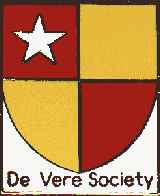The Case Against William Shakspere of Stratford and The Case for Edward de Vere, 17th Earl of Oxford © The De Vere Society 1998  |
The Case Against William Shakspere of Stratford and The Case for Edward de Vere, 17th Earl of Oxford © The De Vere Society 1998  |